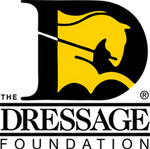2019 U.S. Breeder Excellence Grant Recipient Kendra Hansis, Runningwater Warmbloods
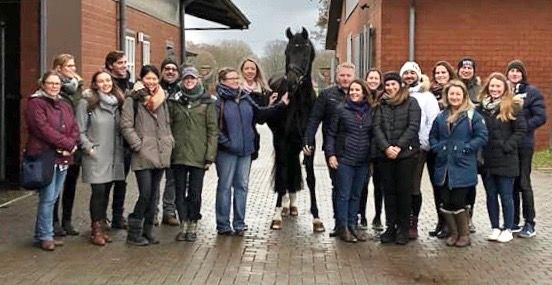
The 2019 Oldenburg Winter Meeting Group with For Romance (Furst Romancier/ Sir Donnerhall) at Lodbergen. That’s me touching his right shoulder.

The Oldenburg Horse Breeders Society, Vechta
I’m so grateful to The Dressage Foundation for awarding me with the 2019 U.S. Breeder Excellence Fund grant! I used the grant to attend the Oldenburg Winter Meeting Breeder’s Course in Vechta, Germany, December 4-7. I’d also like to thank The Dressage Foundation and The Equestrian Journal for providing me with a lovely, horse-friendly journal for recording my time at the Winter Meeting. Thanks, too, to Inge Workel and Peer Eitenmuller, who served as our knowledgeable guides and translators throughout!
At the Winter Meeting I met breeders and riders from around the world and toured several stud farms, including Schockemohle, Ramsbrock, Otten, Stevens, Sprehe, and Lodbergen. I also made my way to Gut Fuchtel, which was not on the list. In this report, I’d like to highlight the trends I observed throughout and discuss what I learned. To add focus, I’ve divided my report into separate discussion points.
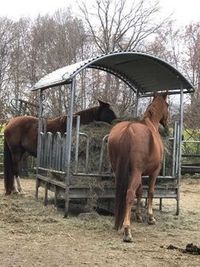
Happy mares at Martin Otten's farm.
Economy of Scale
At farm after farm, I saw an economy of scale rarely seen in the US. A “small” German farm generally breeds 20-50 mares while many large farms breed 100 or more per year. Schockemohle reportedly breeds thousands annually. Horses are kept differently as well. Since it was December, we saw typical winter care: horses separated by age and sex, mares and young horses kept in large barns on straw-covered concrete or brick, fed round bales and, in some cases, silage.
Horses in work are kept in stalls. Straw is added until the entire stall or barn is stripped, usually once a month. Some stalls are designed with swinging dividers, so an entire row of stalls can be opened up and a loader used to remove soiled bedding. Most stalls have permanent mangers for feeding grain and automatic waterers. I saw almost no one mucking an individual stall by hand.
It was hard not to look at the way these farms are set up without considering the absolute practicality applied to basic horse care. How much time, bedding, and hay would be saved using this approach? I know some breeders in the US have similar setups – at least to some degree – but many others wage daily battle against things like unnecessary hay loss, myself included. I’d like to experiment with implementing some of what I saw in Germany to make my farm more efficient and my facilities more useful.
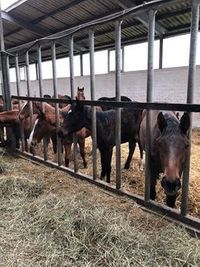
Weanlings at Stall Ramsbrock

Stall with swinging divider
Facilities
Each farm we saw had an indoor arena -- some had multiple – as well as outdoor courts not in use in winter. Often there was one indoor for flatwork and one for jumping. Many farms had treadmills and/ or walkers and multiple barns, since horses are kept indoors all winter. Stallions had their own stalls and were ridden, turned out in small paddocks, and/ or exercised on treadmills or walkers each day. I especially liked hearing that stallions were put on treadmills or in hot walkers before being collected in order to minimize breeding-related injuries. Many farms had lovely grooming areas that included heaters for the horses. Some had separate facilities for raising young stallions for licensing and approvals which included a jump chute and experienced crew.
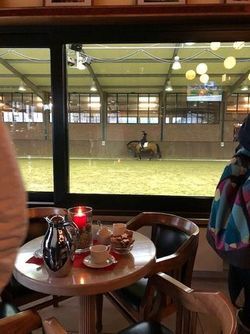
Gestut Sprehe's viewing area.
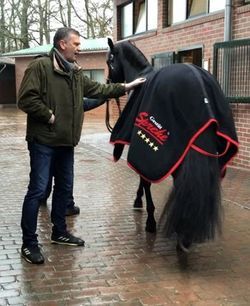
Ulf Schmidt and Millennium at Gestut Sprehe
One especially nice feature at both Gestut Sprehe and Lodbergen was a pub-like viewing area – complete with tables and a bar – adjacent to the indoor. While watching Marc Cain and others, we drank schnapps and talked breeding. Here I had a long discussion with Ulf Schmidt, Gestut Sprehe’s stud manager, about his approach to breeding. We compared mare management strategies and discussed the benefits of multiple breedings with frozen semen. He’s had good results with breeding at ovulation and then again 12 hours later.
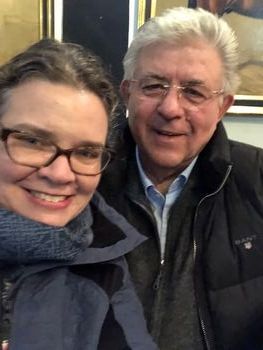
Kendra and Heinrick Ramsbrock
Meeting the Breeders
In addition to the breeders from around the world taking part in the Winter Meeting, I met breeders and breeding directors at each stud farm we visited. Each had a unique view of the business, though many had ideas in common. For example, all believed firmly that the mare contributes more than 50% to any match (most put the mare’s contribution between 50-60%).
I admit to being a bit starstruck at times – as when I met Heinrich Ramsbrock, whose program produced the stallions Furst Heinrich, Escolar, Donnerball, Cornet Oblensky, Cristallo, and many others, including a young Escolar/ DiMaggio stallion being prepared for licensing that dazzled us all.
Despite their many accomplishments, these breeders were happy to chat with us and happy to discuss all aspects of breeding in general. Clearly, customer service is a huge priority. As one member of the tour put it, “people buy horses from people.” It seems simple but it’s true. We only spent a few hours at each farm, but I feel like I’ll always be welcome at each one.
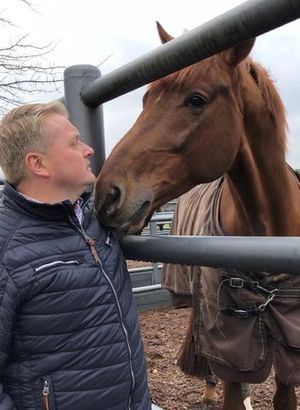
Wolfgang Stagge with four-year-old stallion La Vie (Livaldon/Scolari) at Lodbergen in turnout)
We toured Lodbergen with farm manager Wolfgang Stagge, who explained the basics of horse management at the stud. “I don’t like longeing that much because it’s not good for the feet and so on,” he said, and added, “It’s better riding than longeing.” He stressed the importance of turnout for relaxation and soundness: “Even For Romance [and] Dante [Weltino] they all go out. When [horses] go out every day you don’t have to be nervous for their health. When they stay one week in the box and come out then they are very powerful and hurt themselves.” We saw Rubin Royal, La Vie, and others in individual turnouts specially designed for the stallions’ safety. The turnouts had high steel fences, were deeply bedded with wood chips and enough room for exercise.
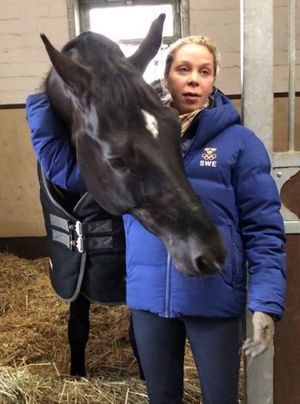
Dante Weltino (Danone I/Welt Hit II) and his rider Therese Nilshagen clearly have a close bond.
Every stallion we met at Lodbergen showed a good character and Dante Weltino was no exception. We were treated to a lengthy discussion about him with his rider, Therese Nilshagen, who has ridden him since he was five. They’ve competed at the European Championships and at WEG with good results and have their sights set on Tokyo in 2020. The stallion is tuned in to his rider and she is effusive in her praise for him: “He really loves to show himself and is very macho in the ring,” she said. “He’s very very very special to me… He’s very sweet and a very gentle horse.” She told us he had a lot of energy as a young horse but has matured into a horse with a “fantastic personality” that never says no. Some of his offspring can be both gentle and sensitive, but, says Nilshagen, “it can be a very good thing that they are sensitive” since that is necessary for competition horses. He tends to produce offspring with a good hind leg and also adds height, so Wolfgang cautions against using him on tall mares. Therese confesses to spoiling him with sugar treats, but, she says, “if we ask a lot of the horses then we also have to give and if they do a good job for me it’s fine to spoil the horses.”
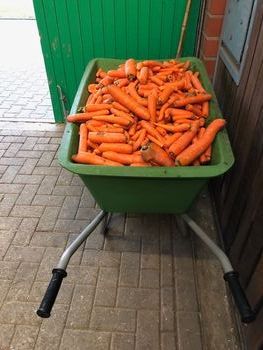
Carrots are fed in bulk at many farms.
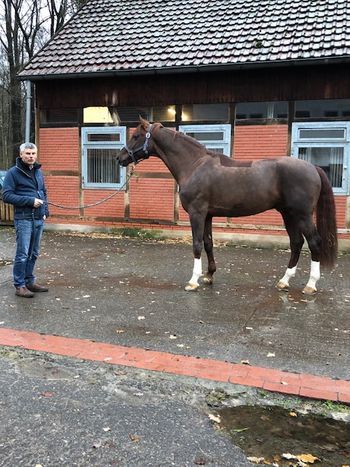
Clemens von Merveldt with Floriscount OLD (Florencia/Dannerhall) at Gut Fuchtel
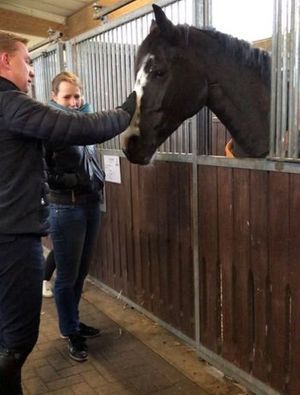
Mario Stevens and Botakara (Balou du Rouet/Esprit)
One morning before our tour started I made a quick trip to Clemens von Merveldt’s Gut Fuchtel to see Floriscount (Florencio/ Donnerhall). I’ve bred three foals by him, the first of which was recently licensed GOV and Westfalen, so this was quite special for me. Of course the stallion did not disappoint! I was struck not just by his physical presence, but by his looks and mannerisms, which I’ve seen many times in his offspring. Clemens gave us a tour of his beautiful farm, Gut Fuchtel, introducing his incredible mare herd and youngstock along the way. His breeding philosophy sets him apart in a number of ways. He keeps a relatively small number of high-quality mares. Almost all are decorated with Elite, States Premium, and Premium titles or are being prepared to earn them. Though he of course owns Floriscount, he doesn’t cover all of his mares with his own stallion, instead choosing a variety of stallions that he feels best compliment his mares. He uses embryo transfer to maximize the offspring production of his best mares – something several breeders and breeding directors we met did not practice. Also, although he buys mares from the auctions on occasion, he doesn’t send horses he’s bred to the auction because he prefers knowing where the horses will go. It matters to him that his horses go to knowledgeable and capable riders.
At Stevens Sportpferde, home of international showjumper Mario Stevens, we were treated to a demonstration focused on introducing a young horse to jumps. Stevens described the path young horses take at his farm, from birth to competition. He was emphatic that they should do nothing before the age of two and not be ridden until three. Introduction to any new task should be gradual. Success should be met with much praise. We watched a horse negotiate a small jump from the trot for the very first time. It balked at first but was met with encouragement and went over. This was repeated a few more times – each time the horse approached with more confidence, the rider firm but positive and praising the horse afterwards – then the horse was put away for the day. Stevens only jumps young horses once a week, explaining that they’re more willing and confident when given patience and time, as rushing any horse brings only bad results.
In breeding, Stevens emphasizes the importance of the mare, which he believes contributes 70% to any foal. He showed us the lovely Stevens-bred mare Chrystal (Cola Zero/ Voltaire), who was unfazed by our group as we surrounded her for a photo, and discussed the importance of character in the competition horse. He introduced us to another of his competition mares, Botakara (Balou du Rouet/ Esprit), also bred on his farm, and described her as “really really special horse,” one he thinks will be his next horse for the big competitions.

Our group with Mario Stevens (center, near treet) and Chrystal (Cola Zero/Voltaire) at Stevens Sportpferde.

The Oldenburg Verband's Inge Workel explains linear scoring and conformation evaluation of a young horse at Martin Otten's.
Evaluation
Each breeder we met reinforced what every good breeder knows: that we must think in generations and we must constantly reevaluate our horses. In recent years, the Oldenburg Verband has introduced linear description, a system which both replaces and offers more information than the traditional 0-10 scale previously used in evaluating horses. Inge Workel, a GOV inspector and one of our guides, explained the system to the group at Martin Otten’s farm in Steinfeld. In linear scoring, each of over 100 qualities may be evaluated and assigned a score of -3 to +3. Zero is average for the Oldenburg breed standard.
For an example, let’s consider length of back. If a horse’s back length, according to the Oldenburg type, is standard for its frame, the score would be 0, so this trait would go unrecorded in the linear scoring, where only notable deviations are scored. If it has a long back, it might receive a +1, +2, or +3, depending on the degree of deviation from average. A short back might be noted with a -1, -2, or -3. An inspector only considers about 15 possible data points for foals, since they are still growing and can’t be fairly evaluated for many traits. Mares and stallions can be evaluated for all traits.
Creating a linear description of each horse inspected allows for the collection of useful data, data that can demonstrate stallions’ prepotencies and help us make informed breeding decisions about mares. A mare that receives a +3 for length of back should not be discounted; it simply means the breeder should choose a stallion reliable for shortening the back. The record of linear profiles amassed for each stallions’ offspring allows us to see which traits each stallion might reliably influence. The Oldenburg Verband has collected over 20,000 linear profiles so far and publishes the results in an annual collection called the Vererbungsprofile. It’s easy to see how useful this information can be compared to the 0-10 scale, which, arguably, only really availed itself of three scores on a regular basis – 6, 7, and 8 – possibly including some half scores. The old system encouraged the comparison of one horse to another (and bragging about high scores received) instead of providing real breeding guidance.
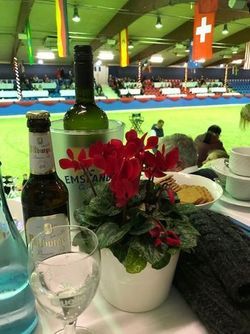
A view from our table at the December Oldenburg Auction
The Oldenburg Organization: Marketing and Hospitality at Its Best
Representing over 10,300 breeders who cover some 6,900 mares to produce 6,450 foals per year (not including those in North America) the German Oldenburg Verband offers centralized registration, evaluation, and sales options to breeders in Europe from its impressive campus in Vechta. Vast main offices connect to barns and the famous indoor festooned with blue and red bunting you’ve no doubt seen in countless images and videos online. Here, the Oldenburg auctions and stallion shows take place, shown around the world via livestreaming. Since there was an auction at the end of the Winter Meeting, we were able to see the auction horses in their stalls, watch them ridden, and could try them ourselves if we chose.
During the Winter Meeting, I saw just how effective the GOV is in hosting interested breeders and riders from around the world, showing and training the auction horses, and creating excitement around the December collection – know as the “Oldenburger Special Edition” -- that fostered interest and sales. Every part of the Winter Meeting and riding horse auction showed an attention to detail and thoughtfulness impressive in its scope. Hotel rooms had equine art and Oldenburg welcome bags. Our tour guides were prompt, courteous, and knowledgeable. Farms, restaurants, travel – everything was organized, clearly explained, and designed to optimize our time.
The auction itself was a marketing marvel. We’d been watching the horses throughout the week, choosing our favorites and guessing the knockdown prices, so when the auction finally arrived everyone was excited. The marketing package for each auction includes a glossy printed book with pages that showcase each horse in the auction. The horse’s auction number, photos, pedigree, basic statistics, and pertinent information on its connections in breeding and sport are provided. All in attendance were given assigned tables laden with snacks. drinks, and flowers. The entire venue was decorated for Christmas and the horses were presented beautifully. Winning bidders were immediately presented with framed photos of their new horse, a bottle of champagne, a purchase agreement, and a box of Christmas ornaments.
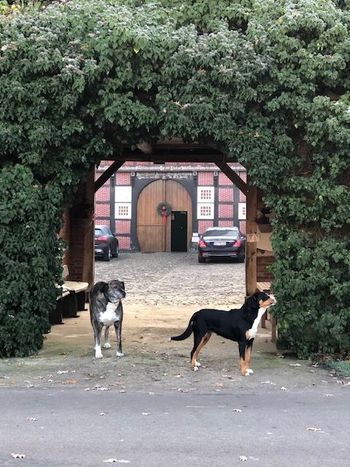
Dogs at Stall Ramsbrock
Takeaways
What did I learn on my trip to the Oldenburg Winter Meeting? I gained an even deeper respect for the Oldenburg registry. The linear description employed by the GOV is a wonderful tool, one we breeders need to understand and use to our best advantage. I appreciated the economic approach, deep understanding of bloodlines, and strong connection to the horse evident in the breeders, riders, and stud managers I met. Lastly – and not surprisingly – I learned that horse people are happy to talk the world over, that breeders who strive to improve will be successful, and that good horsemanship is the same everywhere.
About the Author
Kendra Hansis is an American breeder based in Frenchtown, New Jersey, where she lives with her husband and twin children. She produces dressage foals for professionals and ambitious amateurs on her farm, Runningwater Warmbloods. You can contact her by email at kendrahansis@gmail.com, through facebook, or via her website: runningwaterwbs.net
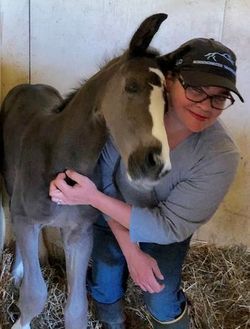
Kendra with Ostentatious H2O (Harvest/Rascalino)
